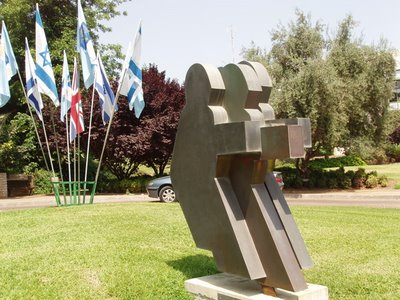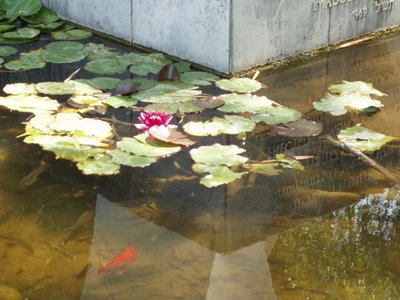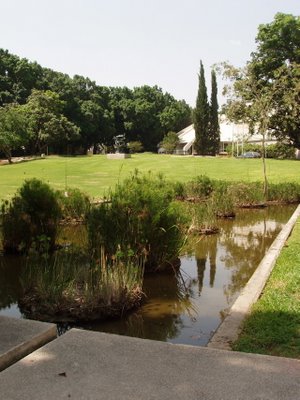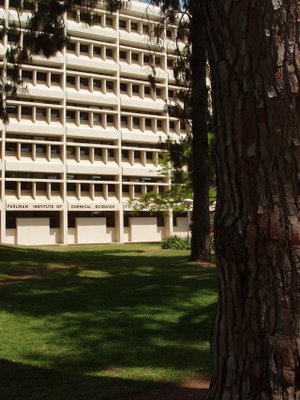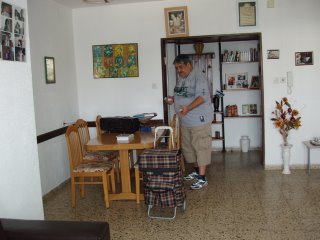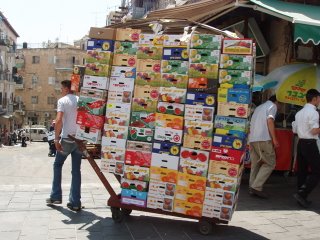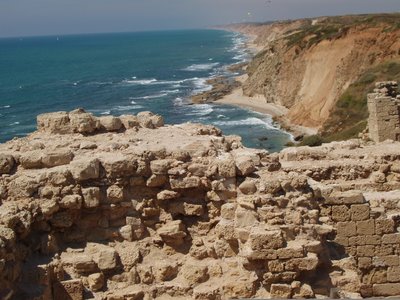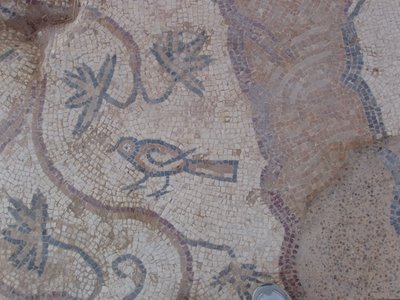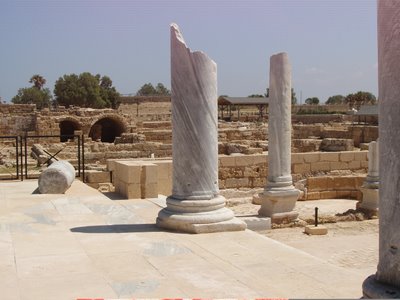Well, the Tel Aviv airport has free wireless access! So here we sit waiting for our flight to Istanbul. We had lots of time, because the lines were all very short or no line at all. We got through electronich checkin, security, passport control, and into the duty free area in around 15 or 20 minutes. The usual questions: this security agent concentrated on learning about our Jewish background and practice. Didn't we learn Hebrew as children? No, we were Reform Jews. Did we belong to a Reform congregation now? No, we are secular Jews, but active in the Jewish community. Also a few questions about what we did in Israel and where our luggage has been spending its time. And that was all. Little pink stickers everywhere.
The only line was to get my VAT back for things I bought at Janet's favorite store Dervish. In line, I was calm. Uncharacteristically. When some people jumped the line and went straight to the window instead of waiting, the people behind me were furious. I remained calm.
I hope the flight and meeting with our Istanbul host go as well as our plans for the day. We packed the last of our stuff, cleaned up the apartment a little, turned in the rental car, house keys and id cards, packed all our stuff in Janet's car, had lunch at her house, and then she drove us to the airport. It seems too easy. There's no plane here at the gate, and only around 3 other passengers, so who knows if the flight will truly leave in a little over an hour. A gate agent just showed up. However, if I keep reporting this activity in real time, it will be the most boring blog post I've ever written.
Wednesday, May 31, 2006
Moving On
Today we plan to return our rental car, pack everything in Janet's car, get to the airport, and fly to Istanbul where we don't expect to have internet access. So I'll catch up with the Turkish part of my travels when I can.
Tuesday, May 30, 2006
Tagine Lunch -- Goodbye
We had a farewell lunch at Ono, a Moroccan restaurant, with Len's host at the Weizmann. The first course, which all of us ordered, was stuffed, batter-coated, deep-fried sardines. The lemon sauce and the hot sauce served with them gave the whole dish a really delicious flavor. Portions were so generous I could have considered it my main course, but then I had chicken and artichoke bottoms over couscous.
The individual main courses each came in a cone-topped tagine serving dish, though these weren't the dishes that the food was cooked in. Lenny had lamb patties with pine nuts and other flavors. A huge plate of tiny red potatoes, fried and spiced, was his side dish.
Before lunch we stopped to look at an orchid grower's greenhouse behind a house on a moshav not far from Rehovot. The moshav subdivided some of its agricultural land a few years ago. On this subdivision, they built a housing development for children of the former members of the collective. The house's current owners bought it after the divorce of the original moshav-descended owner. I guess this is how things are evolving in Israel.
We are just about ready for our departure from Israel tomorrow afternoon.
The individual main courses each came in a cone-topped tagine serving dish, though these weren't the dishes that the food was cooked in. Lenny had lamb patties with pine nuts and other flavors. A huge plate of tiny red potatoes, fried and spiced, was his side dish.
Before lunch we stopped to look at an orchid grower's greenhouse behind a house on a moshav not far from Rehovot. The moshav subdivided some of its agricultural land a few years ago. On this subdivision, they built a housing development for children of the former members of the collective. The house's current owners bought it after the divorce of the original moshav-descended owner. I guess this is how things are evolving in Israel.
We are just about ready for our departure from Israel tomorrow afternoon.
Monday, May 29, 2006
Much more complicated
Ok, in Israel things are always more complicated than they seem to an American. For example, tonight we heard an new reaction about the Hand-in-Hand schools. We described these schools to friends over a beautiful French dinner at a restaurant called Margaux. We explained that the Hand-in-Hand schools seem to attempt to share Jewish, Christian Arab, and Moslem Arab cultures but not to blend them. Our friends hadn't heard of the Hand-in-Hand schools.
From our description, they concluded that such a school had a political agenda. "I didn't hear the people from Hand-in-Hand state a political agenda," I said. Everything in Israel, they reminded me, has a political agenda. If the school has 50% Jews and 50% Arabs, two teachers per class, teaches in two languages, and strives for equal cultural exchange, then (to put it simply) the agenda is to foster a pluralistic country, not a Jewish country. The term "post Zionist" came up.
Our friends described a multi-ethnic school in Jerusalem that has a different agenda. Students include both Jews and Arabs, but "it's like the army. The food is kosher in the dining hall, but the kids can do what they like in their rooms. There's no alcohol for several reasons; the stated one is that there are Muslim students. The general atmosphere is secular Jewish. The key words are tolerance and excellence."
Before their reaction, I would have thought that the major differences were due to Hand-in-Hand being an elementary school and the school they described being a high school. But this is uncomprehending on my part.
Another thing that's becoming obvious to me is that many multi-cultural schools say they are the unique example of such a project, but somehow one always hears of more of them. I wonder how widespread they really are.
I don't know how I'll ever learn to read the complex political agendas that have been swirling around me. This evening I was afraid to even try to describe Jewish Family Education as we learned about it in Migdal haEmek. It's not my style to go over everything and tease out the politics. I'm stuck in American values.
From our description, they concluded that such a school had a political agenda. "I didn't hear the people from Hand-in-Hand state a political agenda," I said. Everything in Israel, they reminded me, has a political agenda. If the school has 50% Jews and 50% Arabs, two teachers per class, teaches in two languages, and strives for equal cultural exchange, then (to put it simply) the agenda is to foster a pluralistic country, not a Jewish country. The term "post Zionist" came up.
Our friends described a multi-ethnic school in Jerusalem that has a different agenda. Students include both Jews and Arabs, but "it's like the army. The food is kosher in the dining hall, but the kids can do what they like in their rooms. There's no alcohol for several reasons; the stated one is that there are Muslim students. The general atmosphere is secular Jewish. The key words are tolerance and excellence."
Before their reaction, I would have thought that the major differences were due to Hand-in-Hand being an elementary school and the school they described being a high school. But this is uncomprehending on my part.
Another thing that's becoming obvious to me is that many multi-cultural schools say they are the unique example of such a project, but somehow one always hears of more of them. I wonder how widespread they really are.
I don't know how I'll ever learn to read the complex political agendas that have been swirling around me. This evening I was afraid to even try to describe Jewish Family Education as we learned about it in Migdal haEmek. It's not my style to go over everything and tease out the politics. I'm stuck in American values.
Sunday, May 28, 2006
Tunnels Along the Western Wall
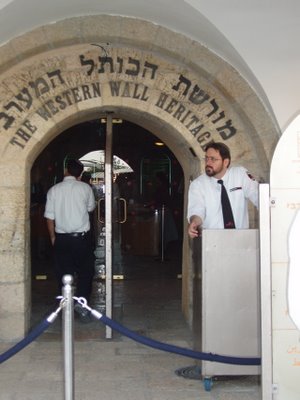
Some years ago, the opening of the tunnels along the Western Wall of the Temple Mount caused rioting among Jerusalem Arabs. Now tourists and Israelis visit this amazing area quietly -- though by appointment only. Our friends Eshel and Michal arranged for a tour this evening.
We found the tunnels amazing. The current Arab city was built above natural ground level next to the along the Western Wall surrounding the ancient Herodian (1st century BCE) Temple Enclosure. Excavations under the existing buildings disclose the huge stones, called ashlars, of the entire Western Wall. The open area of this wall is known as the Kotel, or Wailing Wall, but the visit to the underground area reveals much more of this wall. One stone at the center is enourmous: around 580 tons. The others are big but not that big.
Before the visit, scheduled at 6:40 PM, our first stop was a pastry shop:

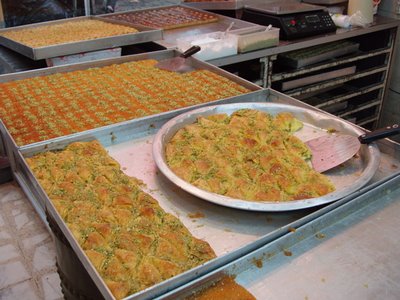
The tunnels:

The big stone:

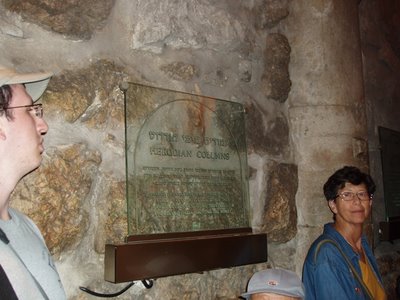
And archaeologists are still excavating:
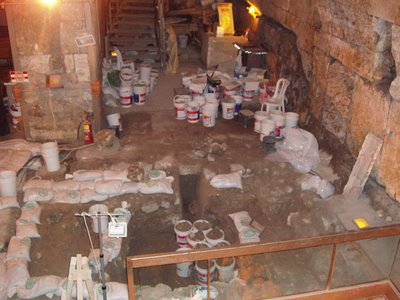
Saturday, May 27, 2006
Saturday: A Walk in the Old City
We entered Jerusalem through the Jaffa Gate. We immediately walked down the center pedestrian street. It's lined with small shops selling jewelry, embroidered cushion covers, textiles of all sorts, sandals, wood carvings, antique and fake Roman glass and ceramics, and tee shirts. Merchandise in many colors hangs from the walls and the roof of the street, really more like a passageway that in places goes underneath buildings. The shopkeepers try to stop you and drag you into their shops, which are very small and open to the walkway.
At the end of the main street, after a bit of wandering and descent via a long staircase, we reached the Western Wall:

After another long walk through the Jewish Quarter and various shopping streets in the Arab Quarter, we made a short visit to the Church of the Holy Sepulchre. Here's an icon:

And here is another icon: the Arabic version of the Coke logo. We drank the cokes at the little outdoor restaurant with our hummus, pita, salad, and really good, freshly-fried falafel:

Here I am at the Jaffa Gate on the way out. Despite the 90 degree heat, you can see my modest covered-up Saturday outfit -- it was a success insofar as no one asked me to leave the prayer area where you can touch the Western Wall and place little notes in the gaps:

Finally, as we left the area I took a view of the outside of the Old City walls, which date from the time of the Ottoman Empire:
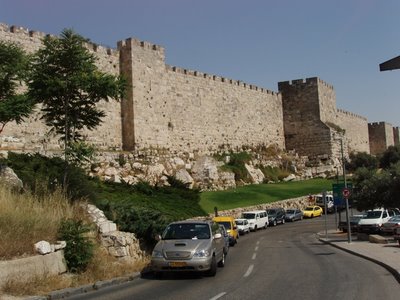
At the end of the main street, after a bit of wandering and descent via a long staircase, we reached the Western Wall:

After another long walk through the Jewish Quarter and various shopping streets in the Arab Quarter, we made a short visit to the Church of the Holy Sepulchre. Here's an icon:

And here is another icon: the Arabic version of the Coke logo. We drank the cokes at the little outdoor restaurant with our hummus, pita, salad, and really good, freshly-fried falafel:

Here I am at the Jaffa Gate on the way out. Despite the 90 degree heat, you can see my modest covered-up Saturday outfit -- it was a success insofar as no one asked me to leave the prayer area where you can touch the Western Wall and place little notes in the gaps:

Finally, as we left the area I took a view of the outside of the Old City walls, which date from the time of the Ottoman Empire:

Dinner at Gilly's in Tel Aviv
Last night we ate at a really wonderful seaside restaurant with Janet and Abigail. It's in the area of the old port of Tel Aviv. I enjoyed a big arugula, tomato, and pine nut salad and a lightly breaded veal cutlet. Lenny had a big steak. For dessert, he and I shared a big, soft, warm chocolate cake with a side of coffee-flavored creme brulee and another side of cardamom-flavored ice cream, and Janet and Abigail shared a fruit-filled puff pastry.
Here are Janet and Abigail on the bridge leading to the old power plant, lit with neon at night:

Here are Janet and Abigail on the bridge leading to the old power plant, lit with neon at night:

Friday, May 26, 2006
Storks
“I lay on a bed of jonquils, staring up at the sky. Flocks of migrating storks soared overhead, circling like tiny water insects on a clear, transparent pond. Back in the Ukraine, two storks had nested in the chimney of Grandfather’s house. ‘I knew that they visited the Land of Israel each year and came back with a bellyful of the frogs of Canaan,’ Grandfather told me. Were the grandchildren of those storks flying over me now?” (The Blue Mountain, p. 84)
This paragraph from Meir Shalev’s book The Blue Mountain illustrates how he constantly ties together his narrator’s own past and present, Israeli history, and Jewish experience. The fictious grandfather’s rich experiences contrast with the narrator’s rather limited horizon. For example, jonquils are native to the Middle East, rooted in the narrator’s environment. The storks, in contrast, are exotic seasonal visitors.
The grandfather’s trek from Ukraine to Palestine, his struggles to learn about fruit trees, cows, and building a house; the misfortunes and deaths of various characters, and the simple narrator’s efforts to cope with so much history make a powerful story. The eccentric and even bizarre personalities of his characters make some episodes ironic or outright humorous. Tragic misfortunes occur in the story, but are often repeated in a less tragic way: an example is the life and slow death of the town’s mule, who immigrated from Russia with some pioneers.
Shalev’s choice of details superimposes the idealism of zionists in the Ukraine, of the immigrants, and of the pioneer farmers onto the reality of the collective farm and its special characters. Throughout the book, the narrator is discovering new details about his parents, his grandparents, the other cofounders of the collective farm in Galilee, and their views as members of “the movement.”
The description of quarrels about the swampiness of the farmland, the deaths of trees from burrowing moths, the breeding of cattle, the dedication and personality of the teacher, and the rivalries between the kibbutz next door and the members of the collective farm make a captivating tale. Reading the book while in Israel has been especially dramatic for me. I could much better picture the farm landscape in the book because I had just visited the Jezreel valley where the events took place.
The author, in the person of the naïve narrator, uses various narrative techniques. Shalev choses extreme events: an uncle’s face disfigured in war, parents violently killed, passionate love and hatred, and the bizarre scheme that has accidently made the narrator a rich man living in an expensive house on the beach in Tel Aviv. The narrator’s wealth arose because he accepted large amounts of money from diaspora Jews who wished to be buried on the farm in Israel. This scheme also illustrates the decline of the idealism and farming ethic of the earlier generations and their “movement.”
The connection between the narrator’s modern cemetery and the ancient burial caves of Bet Shearim was another coincidence for me: we visited this third-fourth century on our trip to that region last week. The events in the book were rather different than our experience: the schoolteacher, an important character in the book, led his students on a hike to Bet Shearim, which at that time was a locally known attraction, not a national park as it is now.
Historic events and politics in the novel are both blurred and heightened by omission of specifics. The narrator repeatedly mentions “another war.” He talks about relationships to English officers, about the neighbor who hid weapons in his outhouse, the cruel injury of his uncle, and other such things, but without naming the war, the controversy, or even the enemy. His use of the term “the movement” avoids explicit discussion of politics in detail. Moreover, he never mentions political parties, generals, or statesmen. Only to some extent can the reader reconstruct the exact historic time line. He thus reinforces the basic humanity and universality of the story, while retaining the particulars of an Israeli experience.
For a reader who doesn’t know Israeli history, the lack of specific detail here might be somewhat disconcerting, but I think Shalev did a masterful job of merging narrative and history. I think the book captures a great deal of the Israeli spirit, and would be enjoyable reading for anyone.
On Wednesday as we drove north, we saw many storks above the road, circling just as Shalev describes, and I thought about the beautiful passage about this transient bird. I’ve often wondered if the Jews in those shtetls knew that their storks had actually passed through the land they only dreamed about: Shalev says they did. To me, it’s all the more meaningful, because my father’s village (just over the border from Ukraine in Belarus) also had storks on its roofs in the summer before he left for America 85 years ago. The storks still come back there, I learned once on the web, though of course all the Jews are long gone.

This paragraph from Meir Shalev’s book The Blue Mountain illustrates how he constantly ties together his narrator’s own past and present, Israeli history, and Jewish experience. The fictious grandfather’s rich experiences contrast with the narrator’s rather limited horizon. For example, jonquils are native to the Middle East, rooted in the narrator’s environment. The storks, in contrast, are exotic seasonal visitors.
The grandfather’s trek from Ukraine to Palestine, his struggles to learn about fruit trees, cows, and building a house; the misfortunes and deaths of various characters, and the simple narrator’s efforts to cope with so much history make a powerful story. The eccentric and even bizarre personalities of his characters make some episodes ironic or outright humorous. Tragic misfortunes occur in the story, but are often repeated in a less tragic way: an example is the life and slow death of the town’s mule, who immigrated from Russia with some pioneers.
Shalev’s choice of details superimposes the idealism of zionists in the Ukraine, of the immigrants, and of the pioneer farmers onto the reality of the collective farm and its special characters. Throughout the book, the narrator is discovering new details about his parents, his grandparents, the other cofounders of the collective farm in Galilee, and their views as members of “the movement.”
The description of quarrels about the swampiness of the farmland, the deaths of trees from burrowing moths, the breeding of cattle, the dedication and personality of the teacher, and the rivalries between the kibbutz next door and the members of the collective farm make a captivating tale. Reading the book while in Israel has been especially dramatic for me. I could much better picture the farm landscape in the book because I had just visited the Jezreel valley where the events took place.
The author, in the person of the naïve narrator, uses various narrative techniques. Shalev choses extreme events: an uncle’s face disfigured in war, parents violently killed, passionate love and hatred, and the bizarre scheme that has accidently made the narrator a rich man living in an expensive house on the beach in Tel Aviv. The narrator’s wealth arose because he accepted large amounts of money from diaspora Jews who wished to be buried on the farm in Israel. This scheme also illustrates the decline of the idealism and farming ethic of the earlier generations and their “movement.”
The connection between the narrator’s modern cemetery and the ancient burial caves of Bet Shearim was another coincidence for me: we visited this third-fourth century on our trip to that region last week. The events in the book were rather different than our experience: the schoolteacher, an important character in the book, led his students on a hike to Bet Shearim, which at that time was a locally known attraction, not a national park as it is now.
Historic events and politics in the novel are both blurred and heightened by omission of specifics. The narrator repeatedly mentions “another war.” He talks about relationships to English officers, about the neighbor who hid weapons in his outhouse, the cruel injury of his uncle, and other such things, but without naming the war, the controversy, or even the enemy. His use of the term “the movement” avoids explicit discussion of politics in detail. Moreover, he never mentions political parties, generals, or statesmen. Only to some extent can the reader reconstruct the exact historic time line. He thus reinforces the basic humanity and universality of the story, while retaining the particulars of an Israeli experience.
For a reader who doesn’t know Israeli history, the lack of specific detail here might be somewhat disconcerting, but I think Shalev did a masterful job of merging narrative and history. I think the book captures a great deal of the Israeli spirit, and would be enjoyable reading for anyone.
On Wednesday as we drove north, we saw many storks above the road, circling just as Shalev describes, and I thought about the beautiful passage about this transient bird. I’ve often wondered if the Jews in those shtetls knew that their storks had actually passed through the land they only dreamed about: Shalev says they did. To me, it’s all the more meaningful, because my father’s village (just over the border from Ukraine in Belarus) also had storks on its roofs in the summer before he left for America 85 years ago. The storks still come back there, I learned once on the web, though of course all the Jews are long gone.

Thursday, May 25, 2006
Yolande's House: For Sandra
Wednesday, May 24, 2006
Mrar, a Druse Village
First, I would like to tell you about the Druse people, who live in a number of villages in northern Israel, the Golan Heights, Syria, and Lebanon. The Druse religion is an offshoot of Islam, but they do not consider themselves to be Moslems. Their village and family life has many traditions, including a reluctance to allow women to work or travel alone outside the village. As a result, widows and unmarried women have had a severely restricted life.
Druse custom is to be loyal citizens of the country where they live. The Druse in the Galilee and near Haifa have consistently expressed loyalty to Israel; they have served in the Israeli army both as enlisted men and officers since 1948, and have fought on the Israeli side in all the wars since then. The Golan Druse remain loyal to Syria, though they intermarry with the Israeli Druse.
On our visit to Mrar, a Druse village in the Galilee, we learned how the Druse are taking the initiative to adapt their customs to life in a modern country. Through a community center and job-training programs, they are controlling their own adaptation to contemporary life and the demands of a changing society. Druse are around 58% of the village inhabitants. Muslim and Christian Arabs make up the remainder of the population; surrounding lands include Jewish cooperative farms and kibbutzes. The main occupation of the villagers is agriculture: they produce olives and olive oil.
Now let me tell you about a Druse woman named Nada. At age 23, she became an IDF widow: that is, her husband died fighting for Israel. She had three small sons and no education. Not long afterwards, she asked her father-in-law if she could study in night school. Despite the objections of members of the family, he agreed to accompany her to school so that she could study but still preserve her and the family's reputation. She completed high school 4 years after her husband's death.
After finishing school, she agreed to design a women's program for the community center, which previously had been for men only. When first faced with the task of writing a plan she cried, but she made the plan and she learned. Her first project was grief counselling for a group of 5 widowed friends. In the beginning, malicious gossip forced them to meet in secret. Over time women's participation in center programs and in educational activities has become much more acceptable in the village.
Nada has now been the head of the women's program for 11 years, working with the director of the center, and teaching women in other villages to do similar things. Her life continues to evolve, and her family is much more supportive. In one month she will get a driver's license -- a very big step for a woman in this village. She is buying a car, so she'll have transportation of her own.
Activities for women at the center include a sewing shop with machines where women can make clothes for themselves or their friends, a theater program for deaf girls, a beauty school where women learn to do makeup, manicures, and hair dressing; and an exercise club (open to women in the daytime, men at night). Through the center, village women have also taken a film course, and run successful businesses filming the women's celebrations at traditional Druse weddings.
"I believe in women's power," says Nada. "Anywhere I hear about an opportunity to create a women's program, I run there. I have a full-time job and I'm a full-time volunteer."
Let me also tell you about Adnan, an actor, an author, a founder of two theater programs, and the energetic director of the Mrar Community Center. His theater for the deaf has given performances within and outside the village. They use Hebrew, Arabic, and Israeli sign language, which is the same for both groups. When the program began around 10 years ago, deaf girls were uneducated and were considered unmarriageable: this is changing. Besides his work developing the community center, he has recently acted in the Israeli film "The Syrian Bride."
He says: "People believe in this place. We don't believe that politics can achieve anything: this is built by the inhabitants themselves." He's seeking money from local businesses to expand the programs, the health club, the theater programs (one for the deaf and another for hearing actors), and all the center's functions. The center also sponsored a multi-cultural festival bringing together members of the 4 religions of the area: Druse, Christians, Muslims, and Jews.
Finally, a word about the owner of a just-opened beauty salon. We met her at the community center, and then visited her new place of business, located in the apartment building where her family lives. She has taken both business courses and the beauty program, and now hopes to succeed in her new endeavor. Her father, whom we met at her salon, is completely supportive.
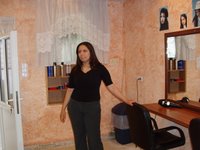
Sponsorship of the job programs is MATI, a much larger job program which receives funding from the Joint Distribution Committee. The beauty school receives funding from the Ann Arbor Jewish community. Center programs also receive funding from the National Insurance Institute.
Note that Mrar is also spelled M'ghar, pronounced more like Mrar.
Druse custom is to be loyal citizens of the country where they live. The Druse in the Galilee and near Haifa have consistently expressed loyalty to Israel; they have served in the Israeli army both as enlisted men and officers since 1948, and have fought on the Israeli side in all the wars since then. The Golan Druse remain loyal to Syria, though they intermarry with the Israeli Druse.
On our visit to Mrar, a Druse village in the Galilee, we learned how the Druse are taking the initiative to adapt their customs to life in a modern country. Through a community center and job-training programs, they are controlling their own adaptation to contemporary life and the demands of a changing society. Druse are around 58% of the village inhabitants. Muslim and Christian Arabs make up the remainder of the population; surrounding lands include Jewish cooperative farms and kibbutzes. The main occupation of the villagers is agriculture: they produce olives and olive oil.
Now let me tell you about a Druse woman named Nada. At age 23, she became an IDF widow: that is, her husband died fighting for Israel. She had three small sons and no education. Not long afterwards, she asked her father-in-law if she could study in night school. Despite the objections of members of the family, he agreed to accompany her to school so that she could study but still preserve her and the family's reputation. She completed high school 4 years after her husband's death.
After finishing school, she agreed to design a women's program for the community center, which previously had been for men only. When first faced with the task of writing a plan she cried, but she made the plan and she learned. Her first project was grief counselling for a group of 5 widowed friends. In the beginning, malicious gossip forced them to meet in secret. Over time women's participation in center programs and in educational activities has become much more acceptable in the village.
Nada has now been the head of the women's program for 11 years, working with the director of the center, and teaching women in other villages to do similar things. Her life continues to evolve, and her family is much more supportive. In one month she will get a driver's license -- a very big step for a woman in this village. She is buying a car, so she'll have transportation of her own.
Activities for women at the center include a sewing shop with machines where women can make clothes for themselves or their friends, a theater program for deaf girls, a beauty school where women learn to do makeup, manicures, and hair dressing; and an exercise club (open to women in the daytime, men at night). Through the center, village women have also taken a film course, and run successful businesses filming the women's celebrations at traditional Druse weddings.
"I believe in women's power," says Nada. "Anywhere I hear about an opportunity to create a women's program, I run there. I have a full-time job and I'm a full-time volunteer."
Let me also tell you about Adnan, an actor, an author, a founder of two theater programs, and the energetic director of the Mrar Community Center. His theater for the deaf has given performances within and outside the village. They use Hebrew, Arabic, and Israeli sign language, which is the same for both groups. When the program began around 10 years ago, deaf girls were uneducated and were considered unmarriageable: this is changing. Besides his work developing the community center, he has recently acted in the Israeli film "The Syrian Bride."
He says: "People believe in this place. We don't believe that politics can achieve anything: this is built by the inhabitants themselves." He's seeking money from local businesses to expand the programs, the health club, the theater programs (one for the deaf and another for hearing actors), and all the center's functions. The center also sponsored a multi-cultural festival bringing together members of the 4 religions of the area: Druse, Christians, Muslims, and Jews.
Finally, a word about the owner of a just-opened beauty salon. We met her at the community center, and then visited her new place of business, located in the apartment building where her family lives. She has taken both business courses and the beauty program, and now hopes to succeed in her new endeavor. Her father, whom we met at her salon, is completely supportive.

Sponsorship of the job programs is MATI, a much larger job program which receives funding from the Joint Distribution Committee. The beauty school receives funding from the Ann Arbor Jewish community. Center programs also receive funding from the National Insurance Institute.
Note that Mrar is also spelled M'ghar, pronounced more like Mrar.
Bringing Ethiopian Immigrants into Society
This morning Lenny and I visited a pre-kindergarten, a well-baby clinic, and a community center that serve the Ethiopian community of Lod, a short distance to the north of Rehovot. Though the distance is small, the economic gap between prosperous Rehovot and the poor apartment neighbohoods of Lod is enormous.
We feel that we witnessed a response to a challenge beyond anything we've heard of. Israel is trying to absorb 105,000 people who come from isolated and totally primitive villages, who have now completely severed their ties with their original culture. When they came to Israel, 70% of the immigrants were illiterate. Now 55% of this community is 18 or younger, and their needs are unimaginable.
Unlike most other places who have admitted or brought in immigrants, the Israelis are making a heroic effort to have their immigrants learn language, culture, and become productive members of a first-world society. Both human resources and material resources on a large scale are deployed for this endeavor. No one knows how this effort will turn out, but we must express our admiration for the commitment.
Our visit was hosted by representatives of the Joint Distribution Committee, which sponsors PACT: Parents and Children Together. The goal of PACT is to help Ethiopian immigrants' children to reach elementary school with at least minimal learning skills and preparation.
At the three site visits, we learned about the programs within PACT. We saw a prekindergarten class -- about half of whom were Ethiopian -- learning about Jerusalem Day. We saw mothers in a class about child care. And we heard the personal and professional stories of three liaison workers who translate and interpret cultural ideas for the Ethiopian parents of small children.
Here is an example of the challenges to those who run the programs. One of the first things on a liaison workers' home vist to new parents is teach basic skills. New mothers and fathers themselves often need to learn such things as counting, using a scissors, and recognizing the letters of the alphabet, as well as basics of childcare. Ethiopian mothers typically use little language in caring for babies; their homes have no books, games,or educational toys, as the parents themselves have rarely attended school. The programs try to encourage parenting skills and improve their eventual relationships with children who will learn things that their parents never experienced.
At the preschool we watched 4 children and a teacher in an enrichment program that intensively teaches them to count, to express themselves, and to play games that prepare for kindergarten. The children were participating in a discussion of the Western Wall for Jerusalem Day, and playing a counting game with blocks that are commonly used for teaching elementary school arithmetic.
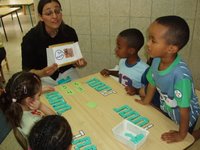
The enrichment teacher works closely with the preschool teacher to coordinate the programs and activities. The preschool is a state school, while the PACT program is funded by the Joint.
At the well-baby clinic, we saw the end of a program on "Summer Safety." The clinic nurse, through the liaison worker, was educating a group of Ethiopian young (and very young) mothers about the danger of allowing children under 10 to swim alone in the sea. Other topics for this group include dental and other hygiene for babies, nutrition, and basic safety, like not allowing small children to go into traffic.
At the community center, we met three Ethiopian immigrant women who serve as translators and cultural liaison workers. One of the three immigrated without her parents at the age of nine. She is now completing a university degree in sociology and counselling. The others came with family as teenagers. All attended boarding schools that provide intensive education for immigrants, though they said that when the started at the school they were sad and lonely.
We learned a great deal about this program and its dedicated staff. The challenge of educating this immigrant group is huge, and the workers are deeply dedicated.
We feel that we witnessed a response to a challenge beyond anything we've heard of. Israel is trying to absorb 105,000 people who come from isolated and totally primitive villages, who have now completely severed their ties with their original culture. When they came to Israel, 70% of the immigrants were illiterate. Now 55% of this community is 18 or younger, and their needs are unimaginable.
Unlike most other places who have admitted or brought in immigrants, the Israelis are making a heroic effort to have their immigrants learn language, culture, and become productive members of a first-world society. Both human resources and material resources on a large scale are deployed for this endeavor. No one knows how this effort will turn out, but we must express our admiration for the commitment.
Our visit was hosted by representatives of the Joint Distribution Committee, which sponsors PACT: Parents and Children Together. The goal of PACT is to help Ethiopian immigrants' children to reach elementary school with at least minimal learning skills and preparation.
At the three site visits, we learned about the programs within PACT. We saw a prekindergarten class -- about half of whom were Ethiopian -- learning about Jerusalem Day. We saw mothers in a class about child care. And we heard the personal and professional stories of three liaison workers who translate and interpret cultural ideas for the Ethiopian parents of small children.
Here is an example of the challenges to those who run the programs. One of the first things on a liaison workers' home vist to new parents is teach basic skills. New mothers and fathers themselves often need to learn such things as counting, using a scissors, and recognizing the letters of the alphabet, as well as basics of childcare. Ethiopian mothers typically use little language in caring for babies; their homes have no books, games,or educational toys, as the parents themselves have rarely attended school. The programs try to encourage parenting skills and improve their eventual relationships with children who will learn things that their parents never experienced.
At the preschool we watched 4 children and a teacher in an enrichment program that intensively teaches them to count, to express themselves, and to play games that prepare for kindergarten. The children were participating in a discussion of the Western Wall for Jerusalem Day, and playing a counting game with blocks that are commonly used for teaching elementary school arithmetic.

The enrichment teacher works closely with the preschool teacher to coordinate the programs and activities. The preschool is a state school, while the PACT program is funded by the Joint.
At the well-baby clinic, we saw the end of a program on "Summer Safety." The clinic nurse, through the liaison worker, was educating a group of Ethiopian young (and very young) mothers about the danger of allowing children under 10 to swim alone in the sea. Other topics for this group include dental and other hygiene for babies, nutrition, and basic safety, like not allowing small children to go into traffic.
At the community center, we met three Ethiopian immigrant women who serve as translators and cultural liaison workers. One of the three immigrated without her parents at the age of nine. She is now completing a university degree in sociology and counselling. The others came with family as teenagers. All attended boarding schools that provide intensive education for immigrants, though they said that when the started at the school they were sad and lonely.
We learned a great deal about this program and its dedicated staff. The challenge of educating this immigrant group is huge, and the workers are deeply dedicated.
Tuesday, May 23, 2006
Markets and other less than usual spots

Natasha and I spent the day walking around an entertaining part of Jerusalem, a mixture of the old and the new. We began at the Italian musuem and synagogue. We continued through small pedestrian streets to the Anna Ticho House, looked around the museum and ate lunch there, walked around more, and ended the day at the large central market and the Ben Yehuda shopping area.
Many buildings in the area are old, some new, some a mixture. In front of a dull and poorly maintained high-rise office and housing building was the gate that once led into the Alliance Internationale Israelite -- the ironwork still had the date 1883, but the stone gates and ironwork were all that remained. The Italian Synagogue building originally was a church belonging to the German Colony, which stands next to a Russian cultural center. The Anna Ticho house was one of the first outside the city wall. Run-down buildings stand next to the offices of important foundations or law firms. In one courtyard is a small stone ampitheater, where a Russian furniture refinishing shop has its activity.
Anna Ticho (1894 - 1981) was originally from Moravia. She joined her husband-to-be, an opthalmologist, in Jerusalem before World War I. For much of her life, she helped him in running an eye clinic, treating problem diseases that troubled residents in the then-primitive city. Trained as an artist, she made many sketches of the trees and hills of Jerusalem. Those on display interested me because she had a way of outlining a whole tree and then detailing only a part such as the trunk.
The New Bezalel school was another of Anna Ticho's interests. The clinic and their home were in one of the oldest houses outside the Old City walls. She left all to the public, so the house now serves as a museum and pleasant place to sit in a garden in the middle of a busy city. A prior inhabitant was named Shapira: a small area in the museum described his career as a forger of antiquities.
We walked around the picturesque streets of the neighborhood, going as far as the sign warning us that we were entering Mea Shearim. The sign told us we would be unwelcome unless dressed to their ultra-orthodox standard, which I think we would never meet. Among the crowds of people on the streets, many conformed to this. Some men wore white shirts, black slacks, visible fringes, and dark skullcaps. Some also wore long black coats. (The temperature is probably well over 80 degrees.) A few wore striped silk coats, kneepants, black porkpie hats, and long black socks. Women wore a variety of hats or snoods, long skirts (some dark, some bright-colored), and long-sleeved blouses.
We looked into two churches: the Russian church, in a busy area near the police station, and the Ethiopian church, surrounded by very expensive homes with gates and gardens. The latter is dramatic: a circular building. Inside, a central area beneath the round dome is inaccessible.

A chained-off door leads into a dark sanctuary. Nearby are benches where there are many, many wooden staffs topped with a short handle, like bishop's crooks. A dark-robed barefoot monk welcomed us. We were also shoeless, as requested by the sign outside the entry.
On the walls of the circular outer aisle are numerous icons, many depicting Ethiopian saints or madonnas with Ethiopian features. Oriental rugs of all colors and types, mostly cheap ones, layer the floors. Plaster walls and pilasters are varied, brightly painted, adorned with cheap metal vases full of artificial flowers and similar decorative objects. Most of the massive doors are painted pale pink. You can look up obliquely towards the deep blue dome painted with disembodied angels in little clouds. Vivid sunlight enters the church from various windows, so it's well lit.
The central market is busy and full of smells: spice, fish, ripe fruit, and frying food. Vivid colors and shapes: piles of dried figs, dates, raisins, prunes, almonds, pecans, walnuts. Burlap bags of spice and fruit-nut mixtures. Fresh green almonds, fresh plums, apricots, tomatoes, cherry tomatoes, apples, pears, cucumbers, onions, squash, beets, kolrabi, green grapes. Dried lentils, peas, fava beans, soup mixes with dried peppers and tomatoes, chili peppers. The whining sound of men at prayers in a stall that serves as a synagogue. A few stall owners call out that you should buy or look at their wares. Refrigerator cases display beef parts, chicken parts, or bowls of condiments and cooked salads. Men and women stand in front of stalls selecting produce to be weighed and packaged.
The jewelry shops along Ben Yehuda street are far less colorful and intriuging than the market. We circled back thorough pedestrian streets to the parking garage next to the Italian museum.
Monday, May 22, 2006
Jerusalem

We are in a wireless-equipped guest house on campus of the Hebrew University of Jerusalem. Just had dinner at home with our friends Baruch and Natasha, who spent a semester at Michigan last year. I enjoyed Natasha's real Russian Borscht, which Lenny declined on the basis of beets. We continue to discuss the extreme statements of A.B.Yehoshua about the inauthenticity of Jewish life other than in Israel.
Jerusalem is unbelievably beautiful: very steep hills with all-cream stone buildings. Some genius in city planning outlawed all other forms of building materials. I went to the Israel Museum which is also very wonderful. At the Shrine of the Book, besides the usual Dead Sea Scrolls, they have the Alleppo Codex, a manuscript of the Bible written in the 10th C and still considered the most authoritive of sources. Unfortunately in anti-Jewish riots in 1948 in Alleppo, Syria, the synagogue that had housed it for centuries was destroyed and about half the pages disappeared. Other related artifacts were also in the exhibit.
The museum itself is very rich in art, including archaeology from the ancient Middle East, expecially here, and a wide variety of other things: Buddhist, Impressionist, ultra-modern Japanese, Jewish ethnology, and more. They are about to reconstruct one of the oldest synagogues from the Americas, which is being transported from Surinam (north of Brazil, site of a 17th C. Jewish settlement). They have had the synagogue transported from Cochin, India, for a long time.

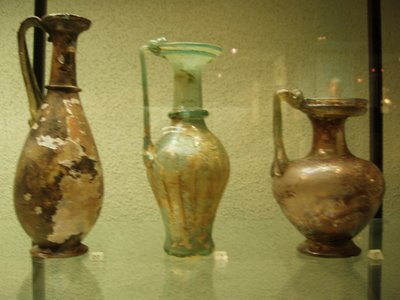
Saturday, May 20, 2006
Eretz Israel Museum, Tel Aviv

Museum garden. The museum has many buildings surrounded by gardens. Most buildings display a single type of work: glass, ceramics, copper and other metals, philately, numismatics. The glass pavillion today had a large and very attractive exhibit of Murano glass from 1920-2005.
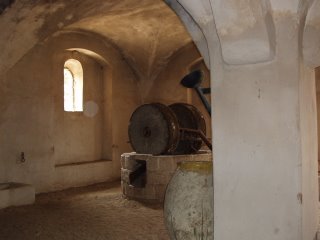
Oil Press: the museum has many displays of ancient practical arts and technologies. They frequently have demonstrations, but none were going on today.

Ancient pottery vessels arranged to show how they were used. Note how the juglets functioned to remove the material from large storage jars.
The German Templars
While we were driving in Tel Aviv, Janet pointed out a construction site where the old German Templar houses are being moved and rennovated. The houses are within a major IDF (Israel Defense Forces) base, and have been used as offices until this historic restoration. They were yellowish stucco with red roofs, and in various states of reconstruction.
Two days later, our guide to the Bet Shearim cemetery in Upper Galilee mentioned that he was doing some research in the archives about the German Templars. Two mentions made me curious, so I googled a bit.
The German Templars were a messianic sect. The founder's name was Christoph Hofmann. His ideas came from 19th century utopian views as well as millenial hopes. He and his followers began to arrive in Palestine in 1868. They built houses in Haifa, in the German Colony in Jerusalem, and also north of Jaffa. The Templars based their neighborhoods on German town plans. The main Tel Aviv community was called Sharona. The Jewish city of Tel Aviv was founded later, not far from their settlement. The Templar neighborhood in Haifa has been preserved, and is a tourist attraction of architectural and historic interest, as of course is the German Colony in Jerusalem.
Because of the interest generated by the restoration of the Templar neighborhood in Tel Aviv, the Eretz Israel Museum in Tel Aviv recently opened an exhibit about them: "The Templars in the Holy Land: Chronicle of a Utopia." Inspired by the articles and also because we wanted to see the rest of the museum, we headed to Tel Aviv this morning, and really enjoyed the exhibit.
The exhibit had photos, water color paintings by visitors, artifacts, diaries, post cards, a household recipe book, school notebooks, and other material, along with detailed historic documentation. Besides the major settlements founded from 1868 to 1878, the Templars also lived in several other areas, including a town, Bethlehem HaGalit, in the area that we visited yesterday.
In addition to the delopment of housing, the German Templars established farms, businesses, European-quality hotels, and transportation for Christian pilgrims. Each settlement had a community center and educational institutions. They also founded hospitals which served the wider community.
Templar businessmen were active in engineering and architecture, and ran businesses such as carriage construction, house-painting, flour mills, bakeries, and a metalworks that employed 100 workers. Eventually they spoke Hebrew as well as German, though most written material on display was in German.
In World War I, after the British conquered Palestine from the Ottomans, the Templars were viewed as enemy aliens, and deported. They came back after the war. In the 1920s, unfortunately, under Nazi influence, some of the Templars joined in the anti-Jewish riots in which Arabs were trying to prevent Jewish settlement under the Balfour declaration. In World War II, the British again began to expel them both to Germany and elsewhere, such as Australia.
The British expelled the last of the community in 1948, just prior to Israeli independence. Templars received restitution for their lost property as part of the post-holocaust agreement between Israel and Germany. The exhibit documented the Templars' Nazi activity, which came at the end of theie time in Israel.
Here is a quote from a letter to Ha'aretz on this subject:
Two days later, our guide to the Bet Shearim cemetery in Upper Galilee mentioned that he was doing some research in the archives about the German Templars. Two mentions made me curious, so I googled a bit.
The German Templars were a messianic sect. The founder's name was Christoph Hofmann. His ideas came from 19th century utopian views as well as millenial hopes. He and his followers began to arrive in Palestine in 1868. They built houses in Haifa, in the German Colony in Jerusalem, and also north of Jaffa. The Templars based their neighborhoods on German town plans. The main Tel Aviv community was called Sharona. The Jewish city of Tel Aviv was founded later, not far from their settlement. The Templar neighborhood in Haifa has been preserved, and is a tourist attraction of architectural and historic interest, as of course is the German Colony in Jerusalem.
Because of the interest generated by the restoration of the Templar neighborhood in Tel Aviv, the Eretz Israel Museum in Tel Aviv recently opened an exhibit about them: "The Templars in the Holy Land: Chronicle of a Utopia." Inspired by the articles and also because we wanted to see the rest of the museum, we headed to Tel Aviv this morning, and really enjoyed the exhibit.
The exhibit had photos, water color paintings by visitors, artifacts, diaries, post cards, a household recipe book, school notebooks, and other material, along with detailed historic documentation. Besides the major settlements founded from 1868 to 1878, the Templars also lived in several other areas, including a town, Bethlehem HaGalit, in the area that we visited yesterday.
In addition to the delopment of housing, the German Templars established farms, businesses, European-quality hotels, and transportation for Christian pilgrims. Each settlement had a community center and educational institutions. They also founded hospitals which served the wider community.
Templar businessmen were active in engineering and architecture, and ran businesses such as carriage construction, house-painting, flour mills, bakeries, and a metalworks that employed 100 workers. Eventually they spoke Hebrew as well as German, though most written material on display was in German.
In World War I, after the British conquered Palestine from the Ottomans, the Templars were viewed as enemy aliens, and deported. They came back after the war. In the 1920s, unfortunately, under Nazi influence, some of the Templars joined in the anti-Jewish riots in which Arabs were trying to prevent Jewish settlement under the Balfour declaration. In World War II, the British again began to expel them both to Germany and elsewhere, such as Australia.
The British expelled the last of the community in 1948, just prior to Israeli independence. Templars received restitution for their lost property as part of the post-holocaust agreement between Israel and Germany. The exhibit documented the Templars' Nazi activity, which came at the end of theie time in Israel.
Here is a quote from a letter to Ha'aretz on this subject:
- Tel Aviv's Yedioth Iriyat newspaper for the Hebrew month of Tevet 1948 reported that some of the Hebrew-speaking Templars, who returned to Germany during the Nazi period, enlisted not in the Wehrmacht, but in the special assassination squads determined to carry out the Final Solution. And don't forget: Adolf Eichmann was a guest in Sharona in the 1930s. At the opening of the exhibit at the Eretz Israel Museum, the German ambassador sorrowfully acknowledged that 30 percent of the Templars were Nazis. (letter to Ha'aretz Yossi Renart, responding to a review of the Tel Aviv exhibit, published May 12, 2006; unfortunately I was not able to locate the review itself which appeared in April.)
Friday, May 19, 2006
Cemeteries, Gardens, and Drama
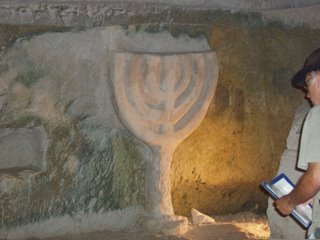
Bet Shearim burial caves
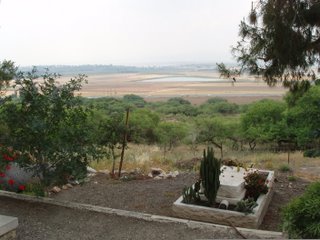
Cemetery of Nahalal with view of Jezreel Valley

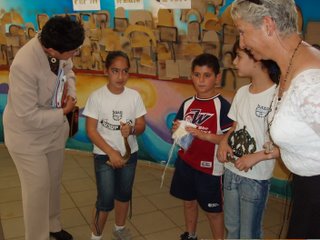
Schoolchildren working in the school garden. Children showing objects that represent their family history.
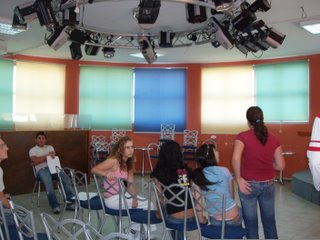
High-school students in the after-school drama program preparing for improvisations.
Subscribe to:
Comments (Atom)
